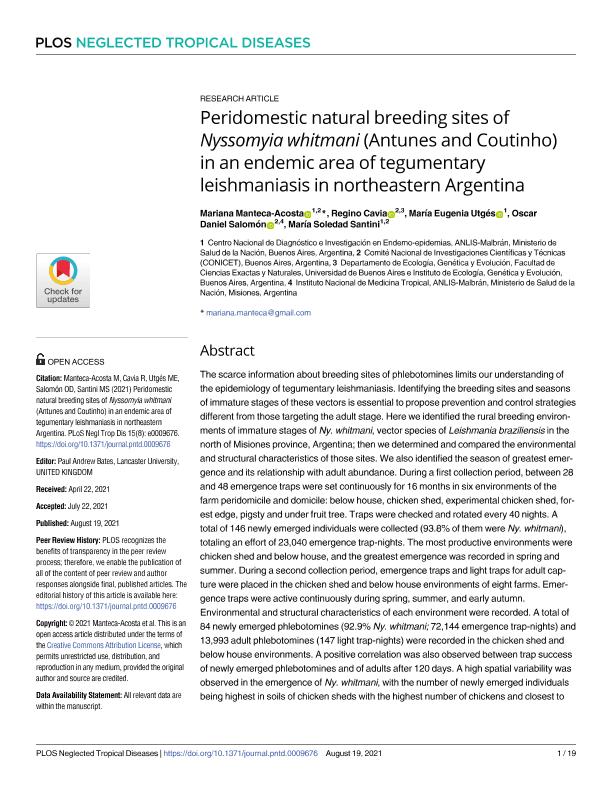Artículo
Peridomestic natural breeding sites of Nyssomyia whitmani (Antunes and Coutinho) in an endemic area of tegumentary leishmaniasis in northeastern Argentina
Manteca Acosta, Mariana ; Cavia, Regino
; Cavia, Regino ; Utgés, María Eugenia
; Utgés, María Eugenia ; Salomón, Oscar Daniel
; Salomón, Oscar Daniel ; Santini, Maria Soledad
; Santini, Maria Soledad
 ; Cavia, Regino
; Cavia, Regino ; Utgés, María Eugenia
; Utgés, María Eugenia ; Salomón, Oscar Daniel
; Salomón, Oscar Daniel ; Santini, Maria Soledad
; Santini, Maria Soledad
Fecha de publicación:
08/2021
Editorial:
Public Library of Science
Revista:
Neglected Tropical Diseases
ISSN:
1935-2735
Idioma:
Inglés
Tipo de recurso:
Artículo publicado
Clasificación temática:
Resumen
The scarce information about breeding sites of phlebotomines limits our understanding of the epidemiology of tegumentary leishmaniasis. Identifying the breeding sites and seasons of immature stages of these vectors is essential to propose prevention and control strategies different from those targeting the adult stage. Here we identified the rural breeding environments of immature stages of Ny. whitmani, vector species of Leishmania braziliensis in the north of Misiones province, Argentina; then we determined and compared the environmental and structural characteristics of those sites. We also identified the season of greatest emergence and its relationship with adult abundance. During a first collection period, between 28 and 48 emergence traps were set continuously for 16 months in six environments of the farm peridomicile and domicile: below house, chicken shed, experimental chicken shed, forest edge, pigsty and under fruit tree. Traps were checked and rotated every 40 nights. A total of 146 newly emerged individuals were collected (93.8% of them were Ny. whitmani), totaling an effort of 23,040 emergence trap-nights. The most productive environments were chicken shed and below house, and the greatest emergence was recorded in spring and summer. During a second collection period, emergence traps and light traps for adult cap-ture were placed in the chicken shed and below house environments of eight farms. Emergence traps were active continuously during spring, summer, and early autumn. Environmental and structural characteristics of each environment were recorded. A total of 84 newly emerged phlebotomines (92.9% Ny. whitmani; 72,144 emergence trap-nights) and 13,993 adult phlebotomines (147 light trap-nights) were recorded in the chicken shed and below house environments. A positive correlation was also observed between trap success of newly emerged phlebotomines and of adults after 120 days. A high spatial variability was observed in the emergence of Ny. whitmani, with the number of newly emerged individuals being highest in soils of chicken sheds with the highest number of chickens and closest to forest edge. Moreover, below house was found to be as important as chicken sheds as breeding sites of Ny. whitmani. Management of the number of chickens in sheds, soil mois-ture and pH, and the decision of where to localize the chicken sheds in relation to the houses and the forest edge, might contribute to reduce the risk of human vector exposure and transmission of Leishmania.
Palabras clave:
CUTANEOUS LEISHMANIASIS
,
PHLEBOTOMINAE
,
BREEDING
,
Ny WHITMANI
Archivos asociados
Licencia
Identificadores
Colecciones
Articulos(CCT - NORDESTE)
Articulos de CTRO.CIENTIFICO TECNOL.CONICET - NORDESTE
Articulos de CTRO.CIENTIFICO TECNOL.CONICET - NORDESTE
Citación
Manteca Acosta, Mariana; Cavia, Regino; Utgés, María Eugenia; Salomón, Oscar Daniel; Santini, Maria Soledad; Peridomestic natural breeding sites of Nyssomyia whitmani (Antunes and Coutinho) in an endemic area of tegumentary leishmaniasis in northeastern Argentina; Public Library of Science; Neglected Tropical Diseases; 15; 8; 8-2021; 1-19
Compartir
Altmétricas



